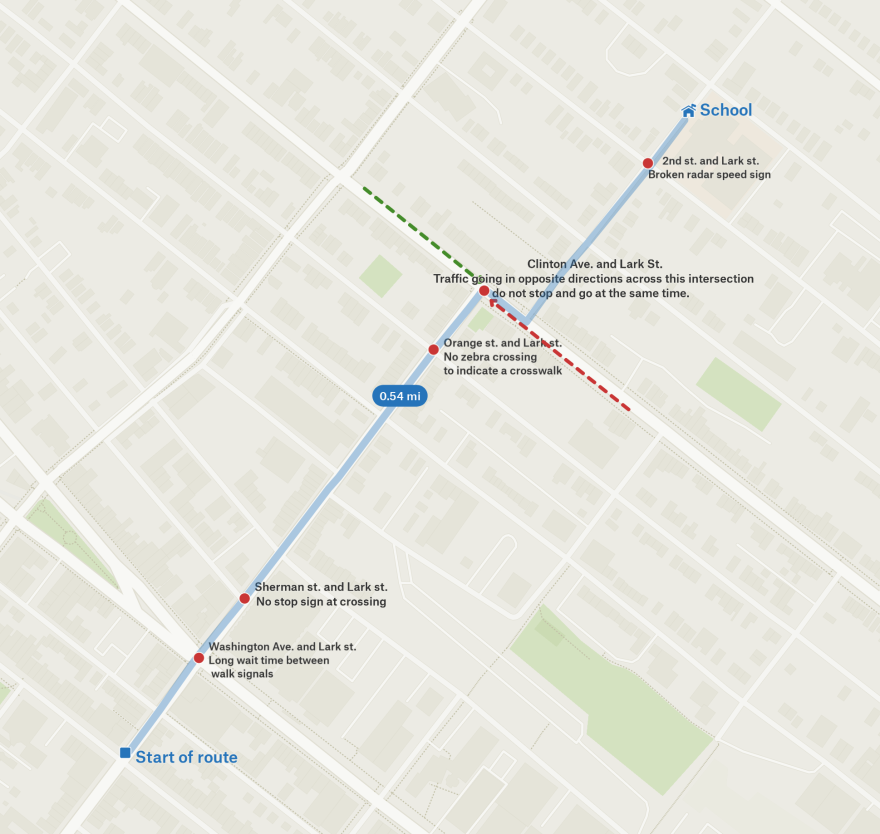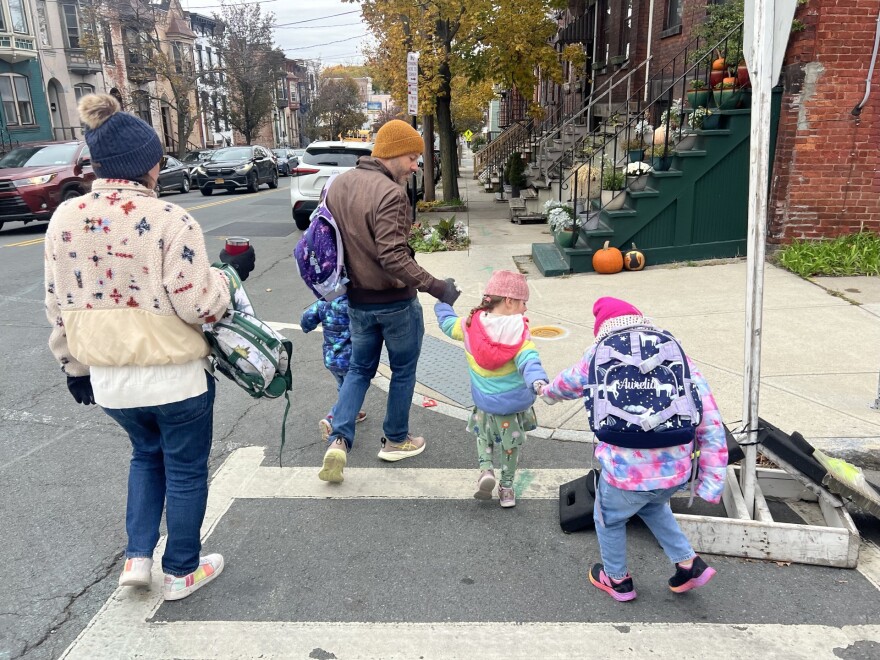From broken signals to faded markings, crosswalks in Albany have a reputation for being unsafe and inconsistent. Now, local advocates and a councilmember are taking concrete steps to address pedestrian safety.
Julia Battista and Jason DiNovi live in Albany’s Center Square with their two children, ages 4 and 6. Battista and DiNovi are part of a walking pool with another family. The parents alternate who walks the children to school, which is approximately half a mile from their homes. On this particular day, it’s Battista and Dinovi’s turn. Along Lark Street, DiNovi, says his concerns about walking through the Arbor Hill neighborhood have nothing to do with stereotypes.
“People will question us sometimes, like, ‘oh, you walk your kids through Arbor Hill,’ you know, as if their concern is going to be a safety issue.” Said DiNovi. “And what they don’t realize is that the real safety issue here, that it's just that people drive like maniacs through the neighborhood, and there's just, there's that rapid enforcement of just having to deal with a lot of these traps. You know, it's just different.”
As he walks the children, he observes as a car on the road commits a traffic violation
“So that's a literal, just a U-turn through a crosswalk, which isn't really even existent here,” said DiNovi. “It looks like it could be painted, but, yeah, you can count on those like every day.”

Although their walk to school only stretches about 10 to 12 blocks, they come across an issue at almost every crosswalk. At the intersection on State and Lark Street, the button to trigger the walk signal is not functioning on all sides, which confuses the children, who are just beginning to learn the rules of traffic safety.
“What these guys don't realize too, pushing the buttons, is that at this particular intersection, it's actually automatic if you're crossing State [street], but if you're crossing Lark [street], you do need to hit the button,” said DiNovi. “So, we have to try to teach them that, that going one direction you need to hit the button in order to have the right away. But otherwise, it's just automatic. Even though it's the same intersection.”
At the intersection of Orange and Lark streets, the crosswalk is confusing and – oftentimes – dangerous.
“There's a faded crosswalk that, I guess indicates you can cross direction, but it's not clear whether or not cars will stop.” said Battista.
“Yeah, I mean, even this is a crosswalk where pedestrians should have right of way, there is no way a car is going to stop if anyone's actually waiting here to try to cross this street,” added DiNovi.
From broken crosswalk signals, to faded zebra crossings, and lack of crosswalk signage, the problems these walkers face occur citywide. In 2023, the New York State Department of Transportation released a Strategic Highway Safety Plan marking Albany as a “high-risk” area for vulnerable road users like people with disabilities, children, and seniors.
According to Kyle Hatch, the planner and cofounder of Capital Streets, a nonprofit that advocates for transportation safety in the Capital Region, Albany crosswalks are unsafe because there is no uniform standard.
“I think what I see a lot in Albany in terms of crosswalks and crossings in general, is inconsistency. Some of them are really great. They're well maintained, they're clear, they follow all of the latest guidelines for safe pedestrian crossing standards, that type of thing. And other places, you look at crosswalks and you just wonder, what the heck happened?” said Hatch. “There are major potholes. The crossing might be completely faded from the paint. It goes completely diagonally across an intersection. So, crossing distances are really long. There's just not a lot of consistency citywide in how crosswalks are treated.”
Hatch added that this uniform language is crucial in making a crosswalk safe for everybody involved.
“I think it's - there are a lot of things that go into making a crossing safe and functional, but at the core of it, I think consistency is one of those really big things. People want to know what to expect. They want things to be clear. So it means crossings need to be visible,” explained Hatch.
“Drivers need to know when a pedestrian is crossing, which means they need to be able to see them. They need to know that the crossing is there. Similarly, pedestrians need to know what to expect, what they can expect when they come up to a crossing.”
Citing these points, Capital Streets worked with Albany Common Councilmember Deborah Zamer to draft an ordinance that would help standardize all crosswalk and traffic signals in the city. Zamer, who represents the 14th Ward, explained that the ordinance would amend city code to include a traffic control signal policy.
“A traffic control signal policy is a sort of an engine, a traffic engineering set of guidelines for how traffic signals should change, how to time them in accordance with what we call vulnerable road users, those who are not in motorized vehicles - cyclists, pedestrians, motorized wheelchairs,” said Zamer. “[So] that it would help to mitigate and lower the risk to pedestrians and cyclists.”
Zamer added that the ordinance would also help the engineering department by creating a standard they can follow when out in the field.
“Our Department of General Services, the departments that are working on our roads, replacing our roads, that when there's a new project, a new infrastructure project, it's really important, in our view, that there's a written policy that details standards for how a municipality programs traffic signals so there's no question about it,” said Zamer. “That is something that we're really hoping to ensure occurs throughout the city, especially when there are new infrastructure projects occurring.”
Zamer intends to introduce the ordinance next year. For now, parents like DiNovi say they will have to make do with the existing signals.
“What’s actually, great about walking is that compared to just being strapped into a car and just appearing at the destination, is they actually get to interact with things. They get to see animals, play on the benches, play in the park. And so, I mean, it's nice to get a little exercise too,” said DiNovi. “But, you know, you just want to be able to do it reliably and safely.”
The City of Albany's Traffic Engineering Division did not respond to WAMC's request for comment.



